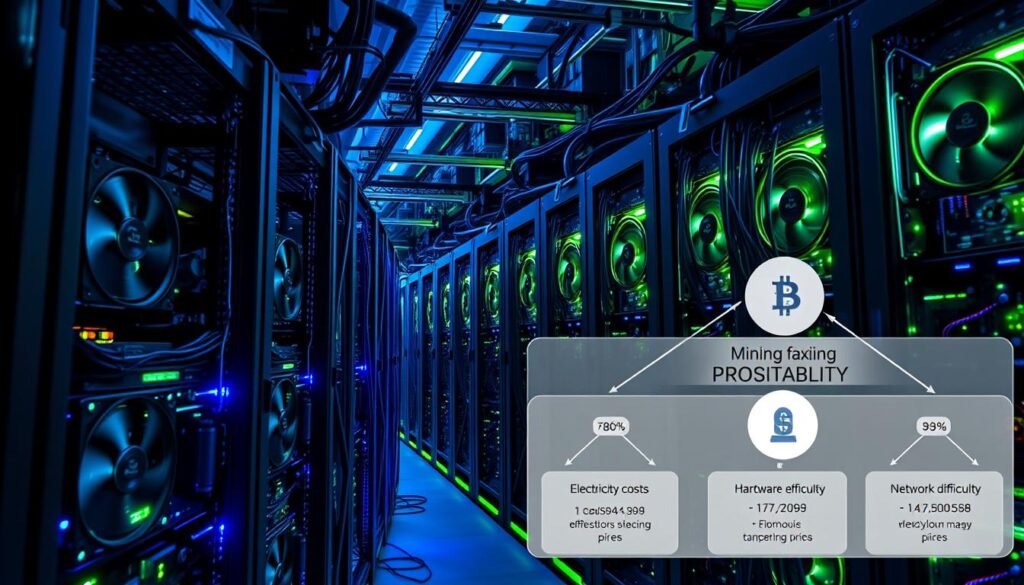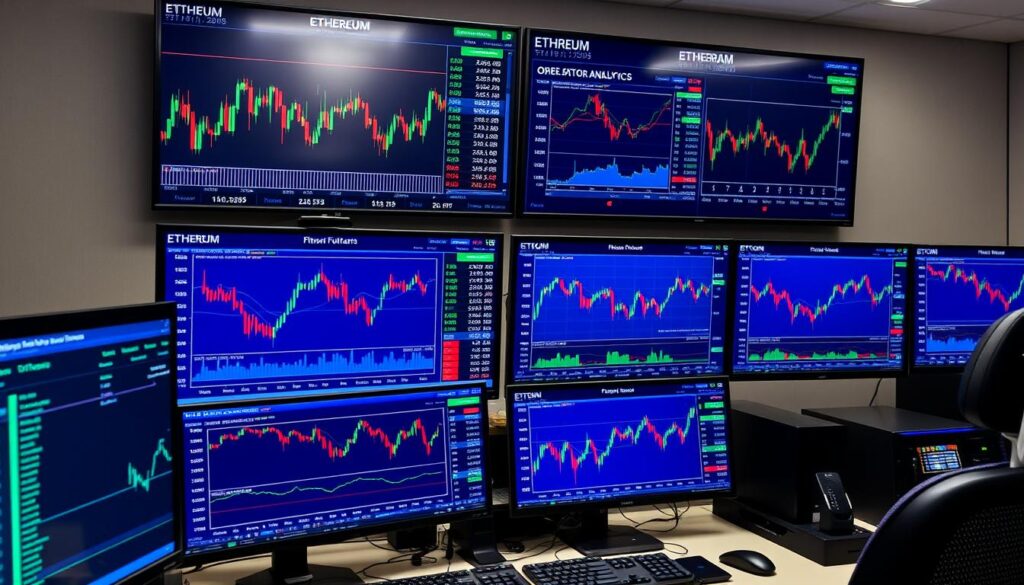Now Reading: Best Cryptocurrency mining profitability calculator tools
- 01
Best Cryptocurrency mining profitability calculator tools
Best Cryptocurrency mining profitability calculator tools

Digital asset extraction has evolved into a sophisticated industry where making informed decisions is crucial. Before investing in expensive hardware, miners need reliable ways to assess potential returns. This is where specialized calculation platforms become invaluable resources.
Platforms like CoinWarz have provided trusted data for over 12 years. They offer real-time statistics for multiple digital currencies including Bitcoin, Litecoin, and Ethereum Classic. These services incorporate current network difficulty, block rewards, and exchange rates to deliver accurate projections.
The landscape now supports various extraction methods beyond traditional Bitcoin mining. Whether you’re considering ASIC or GPU setups, having access to comprehensive analysis tools can significantly impact your success. These platforms help users input specific parameters like hash rate and power consumption to generate realistic earnings estimates.
With constantly adjusting network conditions and price fluctuations, reliable calculation instruments are essential. They help miners navigate competitive markets where margins can be very thin. Choosing the right platform means having access to fresh data and comprehensive configurable inputs.
Key Takeaways
- Specialized calculation platforms help assess potential returns before hardware investments
- Modern tools support multiple digital currencies beyond just Bitcoin
- Real-time data feeds ensure up-to-date profitability estimates
- Accurate projections require current network difficulty and exchange rates
- Platforms like CoinWarz offer comprehensive analysis with 12+ years of experience
- Input parameters include hash rate, power consumption, and electricity costs
- Reliable tools are essential in markets with constantly changing conditions
Introduction to Cryptocurrency Mining Calculators
Modern blockchain participation involves significant upfront investments that require detailed return projections. Specialized calculation platforms have become essential for making informed decisions in this competitive space.
Overview of Mining Profitability Challenges
The digital asset creation process faces numerous economic hurdles. Hardware costs can reach thousands of dollars for single units. Large operations require hundreds of devices.
Electricity expenses vary dramatically by location. They often represent 40-70% of total operational costs. Geographic selection becomes critical for financial success.
The Rise of Mining Calculators in Today’s Market
Calculation tools have evolved from simple estimators to comprehensive platforms. They now offer real-time data feeds and multi-currency support. These resources help users evaluate different hardware options.
Understanding these platforms has become fundamental for blockchain participants. They provide data-driven projections based on current network conditions. Proper mining software configuration works hand-in-hand with these calculation tools.
| Factor | Impact Level | Control Level | Frequency of Change |
|---|---|---|---|
| Network Difficulty | High | None | Regular |
| Electricity Costs | Medium-High | Some | Stable |
| Hardware Efficiency | High | Full | Infrequent |
| Digital Asset Price | Extreme | None | Constant |
Understanding Mining Profitability: Key Factors
Successfully earning Bitcoin requires understanding the delicate balance between network power and market value. Several critical elements determine whether your operation will generate positive returns.

Impact of Bitcoin Price and Network Hash Rate
The BTC exchange rate and network hash rate work together to shape earnings. The Bitcoin price historically rises about 0.34% daily, though market cycles create significant variation.
Meanwhile, the network hash rate grows approximately 0.45% daily. This means your hardware’s share of total network power decreases continuously. Without accounting for this growth, projections appear overly optimistic.
Every validated block currently rewards 3.125 BTC after the recent halving. Transaction fees provide additional income that becomes more important as block rewards diminish.
ASIC Investment and Hardware Efficiency
Choosing the right hardware involves evaluating hash rate, power consumption, and purchase price. Efficiency measured in watts per terahash directly impacts operational costs.
Newer ASIC models continuously enter the market, making older equipment less competitive. Geographic factors like electricity costs also significantly affect whether specific investments can generate positive returns.
Accurate projections must incorporate network growth assumptions. Properly calculate crypto mining profits requires understanding these dynamic relationships between price, network expansion, and hardware performance.
How Cryptocurrency Mining Profitability Calculator Tools Work
Sophisticated projection instruments convert equipment performance data into comprehensive revenue predictions. These platforms analyze multiple variables to generate accurate financial forecasts.
Essential Calculator Inputs and Configurable Metrics
Users begin by entering their hardware’s hash rate and power consumption. Electricity costs represent another critical input for expense calculations.

The hash rate determines computational power measured in terahashes per second. Power consumption figures help estimate ongoing operational expenses. Advanced platforms allow customization of exchange rates and growth assumptions.
Mining Difficulty, Block Rewards, and Data Accuracy
Current network conditions significantly impact projection accuracy. The system difficulty adjusts regularly to maintain consistent block times.
| Calculation Factor | Current Value | Update Frequency | User Control |
|---|---|---|---|
| Network Difficulty | 55,621,444,139,430 | Every 2 weeks | None |
| Block Reward | 3.125 BTC | Every 4 years | None |
| Average Block Time | 599 seconds | Real-time | None |
| Hash Rate Growth | 0.45% daily | Continuous | Adjustable |
Each validated block currently generates 3.125 BTC in rewards. Reliable platforms incorporate real-time data feeds for maximum accuracy. Projections typically extend one year forward using current network conditions.
Top Calculator Comparisons and Feature Highlights
Comparing specialized estimation services demonstrates how feature sets can dramatically influence financial projections. Different platforms offer unique advantages for analyzing digital asset operations.
Comparing ASIC Models and Performance Specifications
Leading hardware for Bitcoin includes the Antminer S19 XP with 138 TH/s and $2,588 annual profit. The Whatsminer M50S+ offers 140 TH/s but higher power consumption.
Performance variations are significant across models. The Antminer S19 Pro+ consumes 5,445W for only 120 TH/s, resulting in much lower returns.

Leveraging Real-Time Charts and Network Timings
Advanced platforms provide real-time hash rate charts showing trends over days, weeks, and years. These visualizations help identify optimal timing for operations.
Network difficulty charts display historical adjustments. This data shows how competition intensifies over time.
Utilizing Accurate Growth Assumptions for Projections
Reliable services incorporate historical network growth data, such as Bitcoin’s 0.45% daily increase. Static assumptions dramatically overstate potential earnings.
Multi-year projection features model different scenarios. They account for BTC price trajectories and changing market conditions.
Practical Tips for Enhancing Your Mining Profitability
Achieving sustainable earnings from computational work demands careful consideration of equipment choices and cost management. Strategic planning can significantly impact your long-term financial outcomes.

Optimizing Hardware Investments
Equipment efficiency measured in watts per terahash directly affects operational costs. Newer models typically offer better performance ratios. This makes them more sustainable over multiple years.
When evaluating hardware, consider the return on investment timeline. Some equipment may never pay for itself. Current network conditions and BTC prices heavily influence this calculation.
| Hardware Model | Efficiency (W/TH) | Projected ROI | Best Use Case |
|---|---|---|---|
| Antminer S19 XP | 21.5 | 12-18 months | Large-scale operations |
| Whatsminer M50S+ | 22.8 | 14-20 months | Medium operations |
| AMD Radeon 7900XTX | 0.28 W/MH | 18-24 months | Multi-algorithm flexibility |
| NVIDIA RTX 4090 | 0.31 W/MH | 16-22 months | GPU-focused setups |
Strategies for Lowering Electricity Costs
Electricity expenses represent the largest ongoing cost for computational operations. Reducing your power rate can dramatically improve profit margins.
Consider negotiating commercial electricity rates instead of residential pricing. This can lower costs by 30-50%. Geographic relocation to areas with abundant hydroelectric power also helps.
Time-of-use pricing structures allow concentration during off-peak hours. This strategy can reduce electricity bills by 20-40%. Proper cooling optimization further minimizes auxiliary power consumption.
Conclusion
Navigating the dynamic world of digital asset creation demands a strategic approach grounded in reliable data. Accurate calculation platforms have become essential for making sound equipment investments and operational decisions.
Understanding core economic drivers—like the BTC exchange rate, network difficulty, and block rewards—is fundamental. These factors directly influence your potential returns and the viability of any operation.
Success hinges on continuous adaptation. As the landscape evolves, maintaining profitability requires regular reassessment of your strategy. This includes optimizing hardware and managing costs, which is crucial for a successful home-based setup.
Ultimately, leveraging precise analytical tools provides the foundation for a sustainable and informed participation in this competitive space.
FAQ
What is the most important factor for determining my potential rewards?
The price of the asset you are mining, like Bitcoin, is the single biggest factor. Your hardware’s hash rate and the network’s total computational power also heavily influence your earnings.
How do block rewards and network difficulty affect my calculations?
Block rewards are the coins you earn for solving a block. Network difficulty adjusts how hard it is to find that block. As difficulty increases, you earn less unless you upgrade your equipment’s performance.
Why is electricity cost such a critical input in these tools?
Your power rate directly eats into your profits. A lower electricity cost can make a previously unprofitable operation viable. Always input your exact local utility rate for an accurate projection.
Can I use these tools to compare different ASIC miner models?
Yes, top calculators allow you to input specs for various ASIC models. You can compare their hash rate, power consumption, and efficiency to see which offers the best return on your investment.
How often should I recalculate my potential earnings?
You should update your calculations frequently. The market is dynamic, with prices, network hash rate, and difficulty changing regularly. Using real-time data ensures your projections stay relevant.
Do these tools account for the long-term growth of a network?
Some advanced calculators let you input assumptions about future price appreciation and difficulty increases. This helps create long-term projections, but remember these are estimates, not guarantees.















